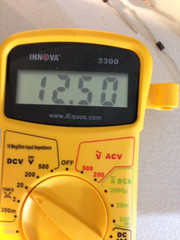Hello All,
I have been working with the Tesla switch and about have it to the point I think its showing some real signs of something strange. I hooked the motor up as a generator and ran the unregulated 20 watt 12volt bulb as the load on the generator Here are some pics.



The interesting thing here is I was getting more voltage out of the battery charger then was going into battery #3 next test is to measure current. also I got a lot of heat from the 20 watt bulb that I plan to try and tap into as well.

-Altrez
I have been working with the Tesla switch and about have it to the point I think its showing some real signs of something strange. I hooked the motor up as a generator and ran the unregulated 20 watt 12volt bulb as the load on the generator Here are some pics.



The interesting thing here is I was getting more voltage out of the battery charger then was going into battery #3 next test is to measure current. also I got a lot of heat from the 20 watt bulb that I plan to try and tap into as well.

-Altrez

Comment